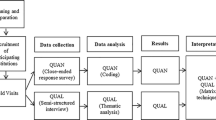Abstract
Background
This qualitative study describes what the integration of complementary and alternative medicine (CAM) means to healthcare policy makers in Canada and examines their recommendations and concerns with regard to the increased integration of CAM in the conventional healthcare system.
Method
The study employed face-to-face interviews with ten provincial government policy makers from Alberta and British Columbia, Canada. The interviews consisted of open-ended questions that focused on the barriers and solutions to the integration of CAM.
Results
Content analysis of the transcribed interviews revealed seven major themes. Participants highlighted the issues that need to be addressed for CAM integration to proceed: the prevention focus in CAM; economic issues; the need for scientific evidence; accreditation and education of CAM practitioners; professional boundary issues; the role of advocacy and strategic planning; and a suggested mechanism for CAM service delivery.
Discussion and Conclusion
The findings indicate policy makers hold a positive view for the integration of CAM at the clinical and primary care level of practice. Policy makers support movement towards integrative health services, but emphasise that the issues of evidence-based CAM research, standards of accreditation and training for CAM practitioners, as well as the issue of who pays for these services, need to be addressed to ensure the improved health and well-being of Canadians.
Similar content being viewed by others
References
Ramsay C, Walker M, Alexander J. Alternative medicine in Canada: use and public attitudes. In: Fraser Institute, editor. Public Policy Sources. 21st ed. Vancouver (BC): Fraser Institute, 1999
De Bruyn T. A summary of national data on complementary and alternative health care — current status and future development: a discussion paper. Ottawa (ON): Health Canada, 2002
The Berger Monitor. Berger population health monitor overview report. Survey no. 22. Toronto (ON): The Berger Monitor, 2001 Mar
Leatt P. Notes from the Editor-in-Chief. Healthc Pap 2003; 3: 4–8
Pelletier KR, Astin JA, Haskeil WL. Current trends in the integration and reimbursement of complementary and alternative medicine by managed care organizations and insurance providers: 1998 update and cohort analysis. Am J Health Promot 1999; 14: 125–33
Best A, Glick D. Research as a tool for integrative health services reform. In: Kelner M, Wellman B, Pescosolido B, et al., editors. Complementary and alternative medicine: challenge and change. Amsterdam: Harwood Academic Publisher, 2000
Boon H, Verhoef M, O’Hara D, et al. Integrative healthcare: arriving at a working definition. Altern Ther Health Med 2004; 10: 48–56
Tataryn DJ, Verhoef M. Combining conventional, complimentary, and alternative health care: a vision of integration. Ottawa (ON): Health Systems Division, Health Policy and Communications Branch, Health Canada, 2001
York University of Health Studies. Complementary and alternative health practices and therapies: a Canadian overview. Toronto (ON): York University of Health Studies, 1999
NDMAC. Fact sheet: Canadian consumers and alternative medicine [online]. Available from URL: http://www.ndmac.ca/index.cfm?fuseaction=main.DspSubPage&PageID=42&SubPageID=803&fkMainPage=42 [Accessed 2005 Dec 18]
Verhoef MJ, Sutherland LR. Alternative medicine and general practitioners: opinions and behavior. Can Fam Physician 1995; 41: 1005–11
Kelner M, Wellman B, Boon H, et al. The role of the state in the social inclusion of complementary and alternative medical occupations. Complement Ther Med 2004; 12: 79–89
Sandelowski M. What ever happened to qualitative description? Res Nurs Health 2000; 23: 334–40
Crabtree B, Miller W. Doing qualitative research: research methods for primary health care. California: Sage Publications, 1999
Van Haselen RA, Reiber U, Nickel I, et al. Providing complementary and alternative medicine in primary care: the primary care workers’ perspective. Compliment Ther Med 2004; 12: 6–16
Easthope G, Tranter B, Gill G. General practitioners’ attitudes toward complementary therapies. Soc Sci Med 2000; 51: 1555–61
White House Commission on Complementary and Alternative Medicine Policy. Final report of the White House Commission on Complementary and Alternative Medicine Policy. Washington, DC: US Government, 2002 Mar 22
House of Lords Select Committee on Science and Technology. Sixth report: complementary and alternative medicine. London: House of Lords Select Committee on Science and Technology, 2000
Thomas KJ, Coleman P, Weatherley-Jones E, et al. Developing integrated CAM services in primary care organizations. Compliment Ther Med 2003; 11: 261–7
Natural Health Products Directorate, Health Canada. Natural health products research [online]. Available from URL: http://www.hc-sc.gc.ca/dhp-mps/prodnatur/report-rapport/qar_tri_oct05_e.html#03_1 [Accessed 2005 Nov 29]
National Center for Complementary and Alternative Medicine. NCCAM funding: appropriations history [online]. Available from URL: http://nccam.nih.gov/about/appropriations/index.htm [Accessed 2005 Nov 29]
British Complementary Medicine Association. Funding boost for research into complementary therapies [online]. Available from URL: http://www.bcma.co.uk/fundingnews.htm [Accessed 2005 Nov 29]
Hess D. Complementary or alternative? Stronger versus weaker integration policies. Am J Public Health 2002; 92: 1579–81
Shuster T, Dobson M, Jauregui M, et al. Wellness lifestyles 1: a theoretical framework linking Wellness, health lifestyles, and complementary and alternative medicine. J Altern Complement Med 2004; 10: 349–56
Bodeker G, Kronenberg F. A public health agenda for traditional, complementary, and alternative medicine. J Public Health 2002; 92: 1582–91
Kelner M, Wellman B. Complementary and alternative medicine: how do we know if it works. Healthc Pap 2003; 3: 10–28
Acknowledgements
We are grateful to the Max Bell Foundation for generously funding this study. Hude Quan is supported by an Alberta Heritage Foundation for Medical Research Population Health Investigator Award and a Canadian Institutes of Health Research New Investigator Award.
The authors have no conflicts of interest that are directly relevant to the content of this article.
Author information
Authors and Affiliations
Corresponding author
Rights and permissions
About this article
Cite this article
Kelly, M., Hardwick, K., Moritz, S. et al. Towards Integration. Evid-Based-Integrative-Med 2, 79–86 (2005). https://doi.org/10.2165/01197065-200502020-00003
Published:
Issue Date:
DOI: https://doi.org/10.2165/01197065-200502020-00003




